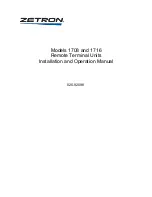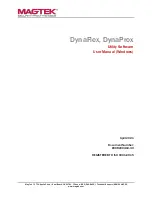
51
Chapter 7:
PromptCOM/ActiveX
Drop-in components are tools that are added to your programming environment "tool kit". There are a variety of different tech-
nologies around for implementing a drop-in component such as VBX (for Visual Basic) and VCL (for Delphi and C Builder) and
COM (ActiveX). Only the ActiveX variety are widely compatible with almost all development environments.
PromptCOM/ActiveX
is a drop in COM component that allows programmers to easily add the ability to send prompts to and re-
ceive data from their RF Terminal via an RF Base Station. It is compatible with Visual Basic, Visual C++, Delphi, and most other
32-bit development platforms. See the help file for installation instructions.
Programming Considerations for ActiveX
Before making any method calls, make sure you :
Set the COM port properties (device name, baud, parity, bits,) as desired. Make sure the port is closed (call
CloseDevice
) be-
fore making changes to any of the port settings.
Call the
OpenDevice
method. This activates the COM port used by this instance of the WDterm control.
Set the
ActiveTerminal
property to identify the terminal on which you desire to operate. You can change the
ActiveTerminal
at
any time in order to direct commands to appropriate terminals.
Test For Good Communication – ActiveX Object
Implement an event handler for
OnTermBaseRegister
that causes a beep or displays a message when called. If communication
between the host PC and the base station is good, your event handler will fire when your program is running and you power up an
attached base station.
Multiple Base Stations
For installations using multiple base stations attached to a single host PC (these were called "channels" in PromptCOM/DLL) simply
add a
WDterm
control to your application for each base station.
Terminal Tracking
Since you get one set of event handlers for each base station, you will need some scheme for keeping track of where each terminal
(up to 64 per base station) is in its transaction sequence. One possible solution is to use a "state" variable for each terminal (per-
haps stored in an array). Test the state variable to determine the next prompt for any given terminal. See the samples for more ide-
as.
It is very important to keep track of "login status" for each terminal. Every
SignOut
event should have an associated
SignIn
event
and a given terminal should not be allowed to
SignIn
twice without an intervening
SignOut
. Multiple
SignIns
from one terminal
without appropriate
SignOuts
indicate either:
A terminal going out of range and having its power cycled before returning within range OR
Two (or more) terminals using the same ID (terminal ID conflict).
Concepts - ActiveX Object Programming
When you use drop-in components in your program you will follow the standard object-oriented programming paradigm that uses
properties, methods, and events to implement the functionality of the drop-in component.
Properties
are the various configuration variables used by the drop-in component. An example of a property is the
ComDevic-
eName
setting.
Methods
are function calls used to issue commands and access features of the drop-in component. An example of a method is
sending an
Input
command to the terminal.
Events
are function definitions placed in your application’s source code. The function definitions in your source code are called
Event Handlers. The skeleton structure of the event handler’s source code is automatically generated. The code in the Event
Handler is called ("fired") by the drop-in component when a specific event occurs. An example of an event is when a terminal
returns data and the
OnTermData
event is fired.
Содержание 7100 RF Terminal Series
Страница 5: ......
















































